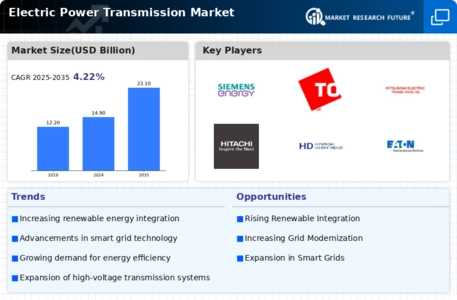Rising Demand for Electrification
The rising demand for electrification is a key driver in the Electric Power Transmission Market. As urbanization and industrialization continue to expand, the need for reliable and efficient power transmission systems is becoming more pronounced. This demand is particularly evident in developing regions, where access to electricity is critical for economic development. According to estimates, the demand for electricity is expected to increase by approximately 25% by 2030, necessitating substantial investments in transmission infrastructure. Utilities are therefore focusing on enhancing their transmission capabilities to meet this growing demand, which is likely to result in increased capital investments and the development of new transmission projects.
Integration of Energy Storage Solutions
The integration of energy storage solutions is becoming increasingly vital in the Electric Power Transmission Market. As renewable energy sources, such as solar and wind, gain traction, the need for effective energy storage systems to manage supply and demand fluctuations is paramount. Energy storage technologies, including batteries and pumped hydro storage, can enhance grid reliability and efficiency. According to recent data, the energy storage market is projected to grow significantly, potentially reaching a capacity of over 300 GWh by 2030. This growth indicates a robust demand for advanced transmission systems that can accommodate these storage solutions, thereby facilitating a smoother transition to a more sustainable energy landscape.
Focus on Energy Efficiency and Sustainability
The focus on energy efficiency and sustainability is reshaping the Electric Power Transmission Market. Stakeholders are increasingly prioritizing the reduction of energy losses during transmission, which not only conserves resources but also lowers operational costs. Initiatives aimed at improving energy efficiency are being supported by both public and private sectors, leading to the adoption of smart grid technologies and advanced transmission materials. The market for energy-efficient transmission solutions is expected to witness substantial growth, with projections indicating a potential increase in market size by over 15% by 2027. This emphasis on sustainability aligns with global efforts to combat climate change and transition towards a low-carbon economy.
Regulatory Support for Clean Energy Initiatives
Regulatory support for clean energy initiatives plays a crucial role in shaping the Electric Power Transmission Market. Governments worldwide are implementing policies and incentives to promote the adoption of renewable energy sources. This regulatory framework encourages investments in transmission infrastructure that can support the integration of clean energy. For instance, mandates for renewable portfolio standards and emissions reduction targets are driving utilities to upgrade their transmission networks. As a result, the market is witnessing an increase in capital expenditures, with investments in transmission infrastructure expected to exceed USD 100 billion by 2025. Such regulatory measures not only enhance grid resilience but also stimulate economic growth in the energy sector.
Technological Advancements in Transmission Systems
Technological advancements in transmission systems are significantly influencing the Electric Power Transmission Market. Innovations such as high-voltage direct current (HVDC) technology and advanced monitoring systems are enhancing the efficiency and reliability of power transmission. HVDC systems, in particular, allow for the long-distance transmission of electricity with minimal losses, making them increasingly attractive for interconnecting renewable energy sources. The market for HVDC technology is projected to grow at a compound annual growth rate of over 10% through the next decade. These advancements not only improve the performance of existing transmission networks but also facilitate the integration of diverse energy sources, thereby supporting a more sustainable energy future.


















Leave a Comment